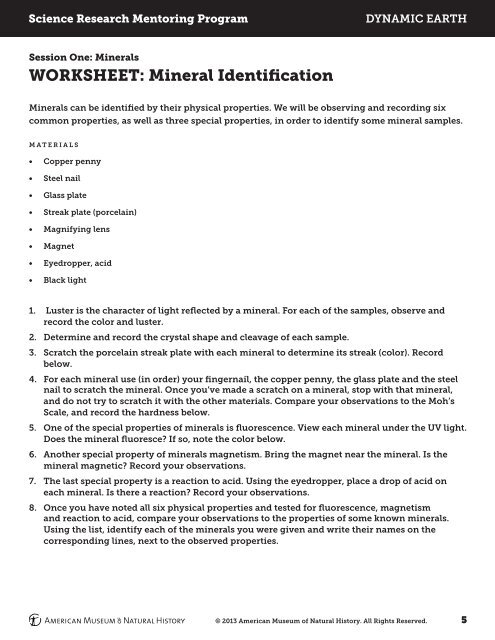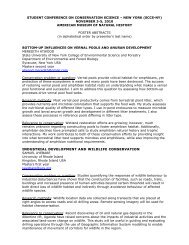SRMP Dynamic Earth Curriculum - American Museum of Natural ...
SRMP Dynamic Earth Curriculum - American Museum of Natural ...
SRMP Dynamic Earth Curriculum - American Museum of Natural ...
Create successful ePaper yourself
Turn your PDF publications into a flip-book with our unique Google optimized e-Paper software.
Science Research Mentoring Program<strong>Dynamic</strong> <strong>Earth</strong>Session One: MineralsWORKSHEET: Mineral IdentificationMinerals can be identified by their physical properties. We will be observing and recording sixcommon properties, as well as three special properties, in order to identify some mineral samples.Materials• Copper penny• Steel nail• Glass plate• Streak plate (porcelain)• Magnifying lens• Magnet• Eyedropper, acid• Black light1. Luster is the character <strong>of</strong> light reflected by a mineral. For each <strong>of</strong> the samples, observe andrecord the color and luster.2. Determine and record the crystal shape and cleavage <strong>of</strong> each sample.3. Scratch the porcelain streak plate with each mineral to determine its streak (color). Recordbelow.4. For each mineral use (in order) your fingernail, the copper penny, the glass plate and the steelnail to scratch the mineral. Once you’ve made a scratch on a mineral, stop with that mineral,and do not try to scratch it with the other materials. Compare your observations to the Moh’sScale, and record the hardness below.5. One <strong>of</strong> the special properties <strong>of</strong> minerals is fluorescence. View each mineral under the UV light.Does the mineral fluoresce? If so, note the color below.6. Another special property <strong>of</strong> minerals magnetism. Bring the magnet near the mineral. Is themineral magnetic? Record your observations.7. The last special property is a reaction to acid. Using the eyedropper, place a drop <strong>of</strong> acid oneach mineral. Is there a reaction? Record your observations.8. Once you have noted all six physical properties and tested for fluorescence, magnetismand reaction to acid, compare your observations to the properties <strong>of</strong> some known minerals.Using the list, identify each <strong>of</strong> the minerals you were given and write their names on thecorresponding lines, next to the observed properties.© 2013 <strong>American</strong> <strong>Museum</strong> <strong>of</strong> <strong>Natural</strong> History. All Rights Reserved. 5
















